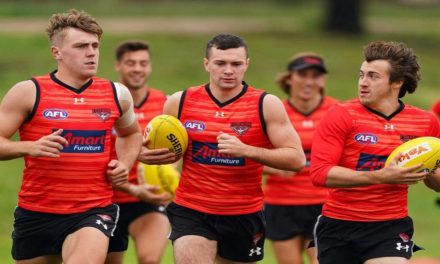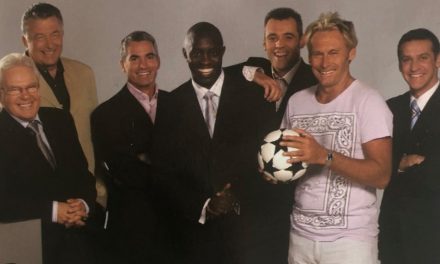Matthew Cottrell puts Carlton in front after the controversial mark which had deflected off an opponent. Photo: AFL MEDIA
One of the greatest attractions of Australian Rules football is its non-stop nature. We don’t have time-outs. Free kicks are paid and taken quickly. And when the umpires do have to blow the whistle and call a halt to proceedings, it’s never for very long.
That continuity keeps the action coming, a major reason ours is to so many of us the greatest sport in the world. But the trade-off is that sometimes we have to live with the odd officiating error. And that’s just a concession we have to be prepared to make.
Fremantle’s unlucky loss to Carlton on Saturday will surely again spark calls for video reviews to be extended from just scores to all manner of decisions. We might see similarly when the much-touted microchipped footballs become reality. And in my view, these calls must be resisted.
Sure, what happened on Saturday was not just dramatic, but for Freo, stiff indeed. And the breathtaking controversy was compounded by Docker Jordan Clark’s subsequent act of dissent being punished in the harshest way possible, a free kick right in front of goal effectively costing his side any chance of clawing back the lead.
But this was rarified territory we literally may never see happen again. And it needs to be put in perspective by those who’d consider an incredibly radical change to how the game is played just to cover off on the very small possibility of a repeat.
Our game is one of the quickest in the world. We don’t tolerate hold-ups very well at all. Consider the amount of impatient foot-tapping and rolling of the eyes which goes on when there’s a pause even for a “blood rule”, let alone a score review. And heaven forbid if that score review is “only” to determine whether a kick is a behind or out of bounds.
I strongly suspect that some of those calling loudest for the capacity to review situations like George Hewett’s kick which deflected off the arm of Fremantle’s James Aish into the arms of Carlton’s Matthew Cottrell for the winning goal, would also be the most annoyed at repeated disruptions to the game’s natural rhythm.
Some sports more naturally lend themselves to video assistance for umpiring decisions. But ours isn’t one of them.
Tennis is an obvious example of a game improved by video technology. Cricket might be another, DRS, the drama which now plays out in any LBW appeal, and the real skill in fielding teams knowing when or not to use one of their limited number of challenges, all adding to the spectacle.
But soccer, I would argue, not so much. Indeed, there’s a good argument VAR has really detracted from the spectacle, few goals now scored without some second-guessing about whether a review is required for the possibility of offside or a foul.
PLEASE HELP US CONTINUE TO THRIVE BY BECOMING AN OFFICIAL FOOTYOLOGY PATRON. JUST CLICK THIS LINK.
Not to mention play continuing to unfold on the odd occasion even for over a minute before being halted because of a VAR overrule. And the world game doesn’t move with the sort of relentless pace Australian football does.
So just how far are we prepared to allow technology’s creep into the way our game is played, the way it inevitably has with other sports?
We’ve had video influencing scoring in AFL long enough now to be able to think that one through and not just reflexively answer “wherever possible”. Because I think the danger in doing that is very real, potentially fundamentally altering the way the game looks.
Personally, I feel like we might have moved a step too far even using video reviews to rule on whether a scoring kick was touched off the boot or not. Once the remit of score reviews was extended beyond just incidents involving specifically the goalposts and goal line, the genie was out of the bottle.
That certainly wasn’t part of the agenda when then AFL football manager Adrian Anderson first spoke of potentially using video to rule on scores after Geelong’s Tom Hawkins’ goal in the 2009 grand final against St Kilda was shown to have deflected off a goal post.
Those extra calls have led to more layers of complexity, more delays, and even the greater sophistication of “The Arc” these days hasn’t eliminated completely the spectre of human error.
Indeed, that infamous goal umpiring error in the Round 23 game between Adelaide and Sydney last year, which effectively cost the Crows a finals berth, nonetheless also exposed inconsistencies with the process of video reviewing.
So, do we really want to impinge on the game more than we currently do in order to facilitate what would no doubt be a futile attempt to completely nail every decision? That’s a lot of potential reviewing in a game where free kicks are quite often marginal and completely open to interpretation.
And just how far back in play would we want our “right of review” to extend? For example, there was an EPL game in 2020 between Tottenham and Manchester City when play continued for a full two minutes before being stopped and a penalty awarded thanks to VAR.
That tested the limits of people’s patience in a game in which lasts only 90 minutes and in which breaks in play are easier to come by. Ours is quicker, more continuous, and lasts generally in the order of 120 minutes, and including breaks, from first siren to last around two hours and 45 minutes.
I’m not sure we should be potentially extending that timeframe significantly just to try to have every base covered. And not just because there’ll always be an incident we hadn’t reckoned upon defying those attempts.
But because surely part of our game’s beauty, along with its constant excitement, is its constant unpredictability. Whether the football gods giveth, as Carlton must acknowledge they did the Blues on Saturday, or, as Fremantle laments, occasionally taketh away.
This article first appeared at ESPN.











